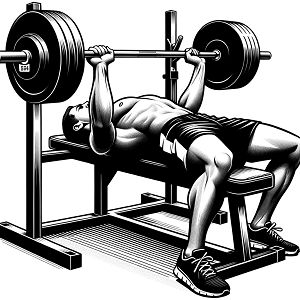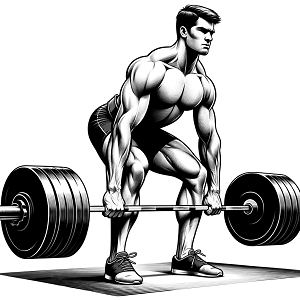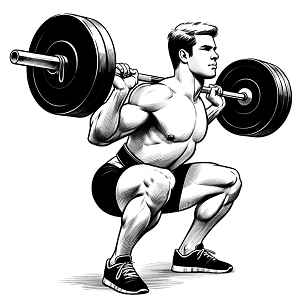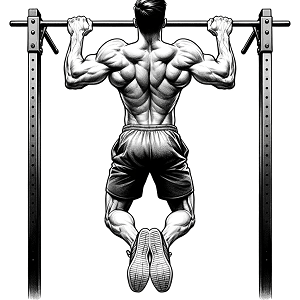The optimal approach for building muscle
When it comes to bodybuilding, many people get lost in the intricacies of exercise plans, diet strategies, and the latest fitness trends. But at its core, building muscle is about stimulating muscle growth through resistance training while allowing your body to recover adequately. To put it simply, it's about balancing four key elements: Volume, Intensity, Recovery, and Caloric Intake.
The Four Pillars
The body has limited resources when it comes to exercising and recovering from exercise.
Balancing volume and intensity is particularily important when it comes to natural bodybuilding.
The reason for this is that ideally, bodybuilding exercises should be performed until total muscular failure is achieved.
This is a necessity to push the muscles to grow. Without a strong enough stimulation,
there's no reason for the muscles to grow.
Very little volume is necessary to achieve maximal muscular stimulation:
A single set performed with 100% effort (meaning until you can't perform another repetition) is sufficient.
Any sets performed beyond this point come at the expense of recoverability.
Volume
Volume refers to the time you spend engaged in weighted exercises. The idea is that more time could lead to more muscle,
but only to a certain extent.
Intensity
Intensity measures how hard you train. Going all out and performing sets to complete muscle failure can produce incredible results but demands a lot from your body in terms of recovery.
Recovery
Recovery is the golden period where your muscles repair themselves, undergoing a process called anabolism, which ultimately makes them grow.
Caloric Intake
This is the energy derived from food that helps you perform daily activities and allows your body to function optimally.
The role of nutrition for muscle growth
While you can't change your genetics, you can adjust your caloric intake. However, eating more won't necessarily mean you'll gain more muscle indefinitely. Too few calories can lead to weight loss, while excess calories might only result in fat gains. The goal is of course to gain as much lean muscle as possible while minimizing fat gains.
Calculating your Total Daily Energy Expenditure (TDEE)
Understanding your daily caloric needs is a crucial foundation for your nutritional plan.
One effective way to estimate this is through calculating your Basal Metabolic Rate (BMR),
which represents the number of calories your body requires to maintain basic physiological functions
like breathing and maintaining body heat when at rest.
The BMR can be calculated using one of several formulas,
such as the Harris-Benedict, Mifflin-St Jeor, or Katch-McArdle equations. Once you have your BMR,
you can then determine your Total Daily Energy Expenditure (TDEE) by factoring in your level of physical activity.
TDEE gives you a more complete picture of how many calories you should consume to either maintain, gain,
or lose weight in conjunction with your fitness goals. For a more tailored calculation,
you can use our online TDEE calculator.
Gaining Muscle Mass: The Weight Dilemma
If I want to build muscle, should I gain or lose weight?
Whether you need to gain or lose weight while focusing on muscle development is influenced by your current body fat percentage.
For those who are sedentary and have little extra muscle mass, the Body Mass Index (BMI) can be a fairly reliable indicator.
If your BMI falls into the overweight or obese categories, the priority should be on losing fat while preserving muscle mass,
commonly known as "cutting."
For an overweight novice lifter who hasn't yet made any substantial gains in muscle mass, it is perfectly possible
to gain muscle and lose fat at the same time.
Conversely, if you're underweight or within the normal range but lean, you might need to focus
on gaining weight to support muscle growth, known as "bulking up".
However, BMI has its limitations as it doesn't directly measure body fat and may not be accurate for those who are
already muscular. Therefore, consulting a healthcare provider for a more comprehensive analysis is advisable.
Caloric Guidelines
To gain weight, aim for an additional 200-400 calories above your TDEE per day.
To lose weight, reduce your intake by 200-400 below your TDEE per day.
Your Total Daily Energy Expenditure can be estimated with this TDEE calculator.
After establishing your TDEE, use a phone app to track your daily caloric consumption. These apps allow you to log your meals and calculate your total daily intake easily.
Weight training
Training: Intensity Meets Efficiency
Exercising to the point of muscle failure requires high energy levels and is demanding on the body. You might feel that individual muscle groups recover quickly, tempting you to train them more frequently or with a wider variety of exercises. But when you have multiple muscle groups to train, the total volume can become overwhelming, making full recovery nearly impossible.
The key to solving this dilemma is efficiency: fewer exercises but higher intensity.
In other words, perform each set to the point of muscle failure while limiting the total number of sets.
A single set of a few basic exercises performed to failure should suffice to achieve maximal muscular stimulation
while avoiding overtraining.
Once a muscle has been stimulated with a high intensity set performed to failure, stimulating the muscle again
by performing additional sets will impair recovery and limit your gains in muscle mass.
This is the likely biggest mistake probably 99,9% of people make when trying to increase their lean body mass.
The Importance of Recoverability
Your ability to recover from workouts is critical because this is when muscle growth (anabolism) occurs. Everyone has a certain capacity to recover, influenced by factors like genetic makeup, stress levels, and nutritional intake. If you push yourself too hard in training, you can exceed your body's ability to recover, sabotaging your muscle-building efforts.
workout plan for muscle gain
Advice for Complete Beginners
If you're a complete beginner and out of shape, jumping straight into a high-intensity workout program could be risky and counterproductive. High-intensity training demands a lot from your body and could lead to injury or excessive fatigue if you're not adequately prepared. Instead, you should focus initially on developing your coordination, balance, and basic fitness level through a lighter, less intense workout plan. These preparatory phases will help condition your muscles, joints, and nervous system for the more strenuous demands of high-intensity training. Once you've achieved a reasonable level of fitness and are comfortable with basic exercise movements, you can gradually transition into a more intense workout routine.
The Efficient Workout Routine to Build Muscle
This simplified program focuses on four core exercises:
- Bench Press
- Deadlift
- Squat
- Pull-ups (or Pulldowns if unable to perform Pull-ups)




These exercises engage multiple muscle groups, thus maximizing the impact of each set. They're also functional movements that our bodies are naturally inclined to perform, which makes them the best exercises for muscular strength and an ideal choice for those looking for the best workout plan for muscle gain.
The Best Workout Plan for Muscle Gain
Before you delve into the intense part of this workout, it's crucial to properly prepare your body for the sets to failure.
Each exercise should be preceded by 4 warmup sets with lighter weights. This step helps to prepare your muscles and nervous system for the intense work that's about to come, reducing the risk of injury and enhancing performance. The warmup sets are not meant to tire you out but to prepare you for the high-intensity set to follow.
Here's a full week workout plan:
This workout program is divided into two different workouts with three days of rest between each session, allowing your body ample time to recover.
Here's a detailed look at each workout:
-Workout 1:
Bench Press: 4 warmup sets, then 1 set of 8-15 reps to failure
Pull-ups or Pulldowns: 4 warmup sets on the pulldown machine, then 1 set of 8-15 reps to failure
Deadlift: 4 warmup sets, then 1 set of 8-15 reps to failure
-3 days of rest
-Workout 2:
Squat: 4 warmup sets, then 1 set of 8-15 reps to failure
Calf Raises: 4 warmup sets, then 1 set of 8-15 reps to failure
-3 days of rest
In this routine, the workouts are spread out to allow for 3 days of rest between them. This rest period is vital for recovery and muscle growth. It gives your body the time it needs to repair the muscle tissue you've broken down during your high-intensity sets, leading to muscle gain.
Important Warning
Caution: The exercises listed in the workout program, especially deadlifts and squats, can be risky if not performed with the correct technique. Improper form can lead to severe injuries. If you're unfamiliar with how to execute these exercises correctly, it's highly recommended that you learn the proper technique under the guidance of a qualified coach before attempting them on your own.
Why Deadlift?
Deadlifts may not be the most popular exercise, mainly because they don't target "showcase" muscles like the chest and biceps. However, they're invaluable for building a well-rounded physique and enhancing your body's fundamental ability to maintain an upright posture.
Conclusion
Building muscle isn't just about lifting weights aimlessly. It's about intelligently balancing intensity, volume, and recovery while keeping an eye on your caloric intake. By focusing on a few but highly effective exercises and pushing each set to the limit, you'll be on the fast track to a stronger, more muscular physique.
Calculators
Ipsum Dolor
Vehicula fermentum ligula at pretium. Suspendisse semper iaculis eros, eu aliquam iaculis. Phasellus ultrices diam sit amet orci lacinia sed consequat.